|
Rather than always linking to Wikipedia entries for common topics, I have
been using ChatGPT to research and post brief summaries on many technical
topics. The results are not always perfect, but I edit them as needed to be
accurate. Courts have ruled that AI-generated content is not subject to
copyright restrictions, but since I modify them, everything here is protected by
RF Cafe copyright. Here are the major categories.
Electronics & High Technology Company
History | Electronics & Technical Magazines
| Electronics & Technology Pioneers History
| Electronics & Technology Principles
| Technology Standards Groups & Industry Associations
| Vintage Vacuum Tube Radio Company History
| Electronics & High
Technology Components |
Societal Influences on Technology |
Science & Engineering Instruments
- See Full List -
 Admiral Radio Admiral Radio
Admiral Radio is a brand of electronic products that was founded in Chicago
in 1924. The company started out as a manufacturer of phonographs and radios,
and quickly gained a reputation for producing high-quality products.
During the 1930s, Admiral Radio became one of the largest manufacturers of
radios in the United States. The company's products were known for their
innovative design and features, such as built-in antennas and tuning indicators.
During World War II, Admiral Radio shifted its production to military
equipment, such as radar systems and communications devices. After the war, the
company returned to producing consumer electronics, including radios,
televisions, and record players.
In the 1950s and 1960s, Admiral Radio continued to innovate, introducing new
products such as the first remote-controlled television set and the first color
television set with a built-in amplifier.
In 1971, Admiral Radio was acquired by the Japanese electronics company,
Panasonic. The Admiral brand was eventually phased out in the United States,
although it continued to be used in other parts of the world.
Today, the Admiral brand is still used in some countries, particularly in
South America, where it is known for producing high-quality electronics at
affordable prices. The company also produces a range of other products,
including air conditioners, refrigerators, and washing machines.
- See Full List -
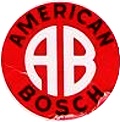 American Bosch American Bosch
The Bosch Group, of which
American Bosch was a subsidiary, was founded in
Germany. It was established by Robert Bosch, a German engineer and
industrialist, in Stuttgart, Germany, in 1886. Robert Bosch was a pioneer in
electrical engineering and a visionary inventor. He was responsible for
developing various innovations in automotive and industrial technology.
The company's early focus was on electrical engineering and, over time,
expanded into a wide range of fields, including automotive components,
industrial technology, consumer goods, and more; e.g., fuel injection systems
and magnetos, and radios.
One of American Bosch's most notable contributions to the automotive industry
was the development of high-pressure fuel injection systems, which were used in
various applications, including diesel engines. These systems improved the
efficiency and performance of internal combustion engines and were an important
advancement in automotive technology.
Over the years, the company underwent various changes and reorganizations. It
eventually became part of the broader Bosch Group, a global leader in technology
and engineering. The name "American Bosch" is not as commonly recognized today,
but the company's legacy lives on through its contributions to the automotive
industry and as part of the Bosch Group's history.
- See Full List -
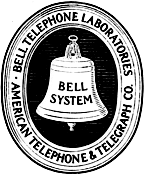 Bell Telephone Laboratories Bell Telephone Laboratories
Bell Telephone Laboratories, commonly known as Bell Labs, has a rich history
of innovation and significant contributions to science and technology. Here’s an
overview:
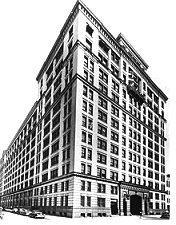 Overview Overview
- Founding: Bell Labs was established in 1925 as the research and
development subsidiary of the American Telephone and Telegraph Company (AT&T)
and the Western Electric Company.
- Purpose: It was created to consolidate the
engineering and research activities of AT&T, aiming to drive innovations in
telecommunications and related fields.
Major Contributions and Innovations
Bell
Labs has been a pioneer in numerous technological advancements, many of which
have had a profound impact on modern technology. Some key achievements include:
Transistor (1947)
- Inventors:
John Bardeen, Walter Brattain, and William
Shockley.
- Impact: The invention of the transistor revolutionized electronics,
leading to the development of smaller, more efficient, and more reliable
electronic devices. It is considered one of the greatest inventions of the 20th
century and is the foundation of modern electronic devices.
Information Theory
(1948)
- Founder: Claude Shannon.
- Contribution: Shannon's groundbreaking work laid
the foundation for digital communication and data compression, fundamentally
changing how information is transmitted and processed.
Laser (1958)
- Developers:
Arthur Schawlow and Charles Townes.
- Impact: The invention of the laser has had
wide-ranging applications, from telecommunications and medical devices to
manufacturing and entertainment.
Unix Operating System (1969)
- Creators: Ken
Thompson, Dennis Ritchie, and others.
- Significance: Unix became a foundational
operating system in computing, influencing many subsequent systems, including
Linux and various forms of Unix.
C Programming Language (1972)
- Developer: Dennis
Ritchie.
- Impact: C has become one of the most widely used programming languages
and has influenced many other modern programming languages, including C++, Java,
and Python.
Nobel Prizes
Bell Labs researchers have won several Nobel Prizes for
their pioneering work:
- 1937: Clinton Davisson for experimental discovery of the diffraction of
electrons by crystals.
- 1956: John Bardeen, Walter Brattain, and William Shockley
for the invention of the transistor.
- 1977: Philip W. Anderson for his
theoretical research on the electronic structure of magnetic and disordered
systems.
- 1978:
Arno Penzias and Robert Wilson for the discovery of cosmic
microwave background radiation.
- 1997: Steven Chu, Claude Cohen-Tannoudji, and
William D. Phillips for developing methods to cool and trap atoms with laser
light.
Organizational Changes
- Post-1984 Divestiture: After the
breakup of AT&T
in 1984, Bell Labs was split into different entities. The primary part remained
with AT&T, while some divisions became part of the Regional Bell Operating
Companies (RBOCs).
- Lucent Technologies: In 1996, AT&T spun off its equipment
manufacturing business, including Bell Labs, into a new company called Lucent
Technologies. Lucent later merged with Alcatel to form Alcatel-Lucent in 2006.
- Nokia: In 2016, Nokia acquired Alcatel-Lucent, and Bell Labs became Nokia Bell
Labs, continuing its legacy of innovation.
Legacy
Bell Labs has left an
indelible mark on science and technology. Its culture of innovation and pursuit
of fundamental research has made it a model for industrial research laboratories
worldwide. The advancements made at Bell Labs have not only transformed
telecommunications but have also had broad implications across various
scientific disciplines and industries.
- See Full List -
 Belmont Radio Corporation Belmont Radio Corporation
Belmont Radio was a manufacturing company that produced a range of radio equipment,
including radios, amplifiers, and speakers. The company was known for its innovative
designs and high-quality products, and was a leader in the radio industry during
its time.
Founded in the early 20th century, Belmont Radio began as a small company that
produced simple crystal radio sets. As radio technology advanced, the company expanded
its product line to include more sophisticated radio equipment, such as amplifiers
and speakers. Belmont Radio also developed its own patented radio technologies,
which helped to set it apart from its competitors.
One of the key innovations that Belmont Radio is remembered for is its development
of the "All-Wave" radio, which allowed listeners to receive broadcasts from around
the world. This was a significant advancement in radio technology, as previous radios
were limited to receiving local broadcasts. Belmont Radio's All-Wave radio was widely
popular and helped to establish the company as a leading manufacturer of radio equipment.
In addition to its radio equipment, Belmont Radio was also known for its distinctive,
high-quality speakers. The company's speakers were designed to deliver excellent
sound quality and were popular with both radio enthusiasts and music lovers. Belmont
Radio speakers were used in a variety of settings, including homes, businesses,
and public spaces.
Unfortunately, as the radio industry evolved and new technologies emerged, Belmont
Radio struggled to remain competitive. The company eventually went out of business,
but its legacy lived on through its many innovations and its high-quality products.
Today, Belmont Radio is remembered as a pioneering company that helped to shape
the radio industry and bring the magic of radio to the masses.
- See Full List -
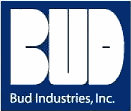 Bud Industries Bud Industries
Bud Industries,
founded in 1928 in Cleveland, Ohio, by Max Haas, has a long history as a manufacturer of electronic enclosures and
related products. The company was initially
called
Bud Radio and catered to the amateur radio market with antennas and antenna
products. Over the years, the company expanded its product offerings to include
various components and enclosures for the electronics industry.
Bud Industries introduced the first NEMA 4X/IP66-rated plastic enclosure. A wide
range of products are manufactured, with a primary focus on electronic enclosures,
cabinets, and racks including a variety of enclosures that meet NEMA and IP (Ingress
Protection) standards which protect against dust, water, and other environmental
factors. A large variety of plastic and metal enclosures are made. Plastic enclosures
are often lightweight and non-corrosive, while metal enclosures provide durability
and protection. Bud Industries also produces 19-inch rack cabinets and accessories
used for housing and organizing electronic equipment, such as servers and networking
devices. A variety of accessories like panels, shelves, and cable management solutions
are made as well.
- See Full List -
 Fluke Corporation Fluke Corporation
Fluke Corporation is a global manufacturer of electronic test and measurement
equipment, founded in 1948 by John Fluke Sr., a former employee of the General Electric
Company, in Seattle, Washington, USA. The company was initially known as John Fluke
Manufacturing Company.
John Fluke's initial focus was on designing and manufacturing accurate and reliable
measurement instruments. In 1953, Fluke introduced its first product, the Model
803 Voltage Detector, which was designed to detect the presence of voltage in electrical
circuits.
Over the next few decades, Fluke Corporation continued to expand its product
line, introducing a wide range of electronic test and measurement equipment, including
multimeters, oscilloscopes, signal generators, and thermal imaging cameras.
In the 1960s, Fluke Corporation expanded its product line to include clamp-on
meters, which allowed electricians and technicians to measure current without breaking
the circuit. The company also developed the first battery-powered portable oscilloscope,
which was widely used in the telecommunications industry.
In the 1970s, Fluke Corporation introduced the first digital multimeter, which
could measure multiple electrical parameters with high accuracy. This product revolutionized
the industry and quickly became a best-seller. In the 1980s, the company continued
to innovate with products such as the first hand-held thermal imaging camera for
industrial use.
In the 1990s, Fluke Corporation introduced a range of test and measurement products
for the data communications and networking industry, including cable testers, fiber
optic testers, and LAN analyzers. In 1998, the company was acquired by Danaher Corporation,
a leading manufacturer of industrial and consumer products.
Today, Fluke Corporation is a global leader in the test and measurement industry,
with a wide range of products that include digital multimeters, thermal imagers,
insulation testers, power quality analyzers, and more. The company continues to
innovate and develop new products to meet the changing needs of its customers.
- See Full List -
 Hazeltine Corporation Hazeltine Corporation
Hazeltine Corporation was a prominent American electronics company that
played a significant role in the development of various military and aerospace
technologies during the mid-20th century. The company was founded in 1924 by
Louis Alan Hazeltine, along with Dr. Marvin Camras and Dr. Frank Lewis, and it was headquartered in Chicago,
Illinois. Hazeltine Corporation was known for its contributions to the fields of
radio engineering, radar, and electronic countermeasures.
During World War II, Hazeltine was involved in the
development of radar systems for military applications. Their work on radar
technology was crucial in improving the effectiveness of air defense and
anti-submarine warfare. Hazeltine's engineers developed the AN/APG-36 illuminator
radar, which was used in the AIM-7 Sparrow air-to-air missile system,
significantly enhancing its accuracy and effectiveness. The company also worked on electronic
countermeasures systems to jam enemy radar and communication systems, which
helped protect military aircraft and ships. Hazeltine was also involved in the development of
television technology and electronic communication systems.
In 1973, Hazeltine Corporation became part of Emerson Electric
Co., which was a global technology and engineering company.
- See Full List -
 Philco Corporation: A Brief Overview and Historical
Context Philco Corporation: A Brief Overview and Historical
Context
Philco
Corporation, also known as the Philadelphia Storage Battery Company, was a prominent
American consumer electronics company that specialized in the production of radios
and televisions. It was founded in Philadelphia in 1892 as the Helios Electric Company
and later changed its name to the Philadelphia Storage Battery Company in 1906.
During the early years, Philco primarily manufactured storage batteries for various
applications, including electric vehicles and radio receivers. However, it wasn't
until the 1920s that the company began producing radios under the Philco brand name.
Philco quickly gained popularity for its innovative designs and reliable performance,
becoming one of the leading radio manufacturers in the United States.
In the 1940s, Philco expanded into television production, capitalizing on the
growing demand for this emerging technology. The company introduced a range of television
sets, including black-and-white models and later color televisions. Philco's televisions
were known for their quality construction and advanced features, and the brand became
a trusted name in the industry.
1945, Philco Corporation owned and operated WPTZ, a television station located
in Philadelphia. WPTZ, which was originally licensed as W3XE, was one of the pioneering
television stations in the United States. It began broadcasting experimental television
programs in the 1930s. Philco Corporation, being a major player in the consumer
electronics industry, recognized the potential of television and acquired the station
in 1941. The acquisition allowed Philco to have a direct stake in the emerging television
market.
Under Philco's ownership, WPTZ expanded its operations and became a fully licensed
commercial television station. The call letters were changed to WPTZ, standing for
"Philco Television Station, Philadelphia." The station continued to broadcast a
variety of programming, including news, sports, and entertainment content.
Over the years, Philco continued to innovate and introduce new technologies.
In the 1950s, they introduced the Predicta line of televisions, featuring distinctive
designs with swivel screens and futuristic styling. However, despite its success,
Philco faced increasing competition from other consumer electronics manufacturers,
and the company began to decline in the 1960s.
Philco went through various ownership changes and financial struggles in the
following decades. The original Philco Corporation went bankrupt in 1960, and the
brand changed hands several times. Today, the Philco name is no longer actively
used in the consumer electronics market.
- See Full List -
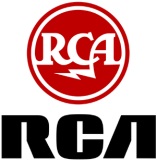 Radio Corporation of America (RCA) Radio Corporation of America (RCA)
The
Radio Corporation of America (RCA) was founded in 1919 as a subsidiary of
General Electric (GE), but became an independent company in 1929 when GE was
required to divest itself of RCA by the U.S. government due to antitrust
concerns. RCA
quickly became a dominant player in the
radio and electronics industry. Its early success was due in part to the
fact that it held key patents on radio technology.
One of RCA's major contributions to the electronics industry was the
development of the first commercially successful radio broadcasting system in
the United States in the 1920s. RCA also played a major role in the development
of emerging television technology, and was instrumental in the introduction of
color television in 1954.
RCA's early years were marked by a series of high-profile achievements,
including the first transatlantic radio broadcast in 1922 and the introduction
of the first commercial radio network, the National Broadcasting Company (NBC),
in 1926.
RCA also played a major role in the development of the phonograph and record
industry. In the 1950s and 1960s, RCA's record label, RCA Victor, was one of the
largest and most successful in the world.
During World War II, RCA played a critical role in developing radio and radar
communications systems and was a major supplier of electronic equipment to the
U.S. military. After the war, the company focused on expanding its consumer
electronics business. After the war, RCA continued to innovate in the
electronics industry, developing technologies such as the first liquid crystal
displays (LCDs) and the first digital video recorders (DVRs).
In the 1980s, RCA was acquired by General Electric, and its operations were
gradually integrated into GE's other electronics businesses. Today, the RCA
brand is still used on a variety of consumer electronics products, but the
original company no longer exists as an independent entity.
Despite its early success, RCA began to struggle in the 1970s. The company
was slow to embrace new technologies like digital audio and video, and it faced
increased competition from Japanese electronics companies.
In 1986, RCA was acquired by General Electric (GE) in a deal worth $6.28
billion. GE spun off RCA's consumer electronics division in 1987, and the
company's remaining assets were folded into GE's other businesses.
- See Full List -
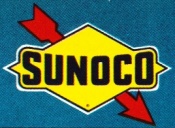 Sunoco (Sun Oil Company) Sunoco (Sun Oil Company)
Sunoco, short for Sun Oil Company, is an American energy company that was originally
founded in 1886 as The Peoples Natural Gas Company in Pittsburgh, Pennsylvania.
Over the years, it evolved and expanded its operations, eventually becoming Sun
Oil Company. Sunoco is primarily known for its involvement in the oil and gas industry,
with activities including the refining, distribution, and marketing of petroleum
and petrochemical products.
Here are some key points about Sunoco:
Refining and Marketing: Sunoco has historically been involved in the refining
of crude oil into various petroleum products, including gasoline, diesel fuel, and
lubricants. The company also operates a network of gas stations and convenience
stores, often branded as Sunoco, where it sells its products to consumers.
Sunoco LP: In recent years, the company has shifted its focus to become a fuel
distributor and retail operator through its subsidiary, Sunoco LP. Sunoco LP operates
convenience stores, fueling stations, and terminals in various states across the
United States.
Sunoco's History: Sunoco has a long history in the oil and gas industry and has
been involved in various ventures and acquisitions over the years. It was a prominent
player in the early development of the American oil industry.
Sunoco Logistics: Sunoco Logistics Partners LP, now part of Energy Transfer Partners,
was a separate entity that focused on the transportation, storage, and distribution
of crude oil, refined products, and natural gas liquids. It played a significant
role in the energy infrastructure of the United States.
Changes and Divestitures: Over time, Sunoco has gone through various changes,
including selling or divesting certain assets and businesses. These changes were
often made to adapt to evolving market conditions and focus on core operations.
- See Full List -
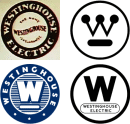
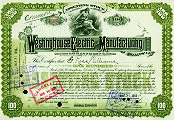 Westinghouse Electric Corporation Westinghouse Electric Corporation
George Westinghouse (1846-1914) was an American entrepreneur and inventor who
played a significant role in the development of the electrical industry. In 1886,
he founded Westinghouse Electric & Manufacturing (later changed to Westinghouse
Electric Corporation), initially focusing on electrical equipment, including transformers
and generators.
In the late 19th century, there was a debate over whether direct current (DC)
or alternating current (AC) should be the standard for electrical power distribution.
Thomas Edison championed DC, while Westinghouse and
Nikola Tesla, a Serbian-American
inventor and engineer, advocated for AC. Tesla's work on AC power systems
included the development of the induction motor and the transformer, making it practical
to transmit electricity over long distances. This laid the foundation for the widespread
use of AC in power distribution. Thomas Edison, a proponent of direct current (DC),
engaged in a battle with Westinghouse and Tesla. Edison conducted a campaign to
discredit AC, emphasizing its alleged dangers compared to the supposedly safer DC.
The rivalry reached its peak with the "War of Currents," a series of events and
public demonstrations where both sides sought to prove the superiority of their
respective systems. Ultimately, the efficiency and practicality of AC won out. The
success of the Niagara Falls Power Project in 1895, which utilized AC power generated
by Westinghouse equipment, demonstrated the viability of long-distance transmission
of electrical power.
Prior to his involvement in the electrical industry, George Westinghouse made
significant contributions to rail transportation. He invented the air brake, a system
that allowed train operators to control the braking of all cars simultaneously.
The Westinghouse Air Brake Company, founded in 1869, became a major player in the
railroad industry.
The Westinghouse Electric Corporation was a diversified company involved in various
industries, including radar, jet engines, generators, motors, and appliances. During
World War II, Westinghouse played a crucial role in the development of radar technology.
The company was involved in both ground-based and airborne radar systems. Westinghouse
engineers contributed to the design and production of radar systems that were vital
for military operations, including aircraft detection and navigation. They were
also involved in the development of jet engines. After World War II, the company
worked on jet propulsion technology. In the 1940s and 1950s, Westinghouse developed
and produced jet engines for military aircraft. Westinghouse Electric was a major
player in the manufacturing of generators and electric motors. The company produced
a wide range of electrical equipment, including generators for power plants and
motors for industrial applications. Westinghouse was well-known for its consumer
appliances, manufacturing a variety of household products, including refrigerators,
washing machines, ovens, and more. Additionally, Westinghouse Electric Corporation
had a broad range of interests and contributions including nuclear power and the
commercialization of nuclear power plants. Westinghouse was a significant player
in the broadcasting industry, owning radio and television stations and producing
broadcasting equipment. Defense Technologies: Apart from radar and jet engines,
Westinghouse had a presence in various defense technologies, including electronic
systems and missile guidance systems.
|








 Admiral Radio
Admiral Radio American Bosch
American Bosch Bell Telephone Laboratories
Bell Telephone Laboratories Overview
Overview
 Belmont Radio Corporation
Belmont Radio Corporation Bud Industries
Bud Industries
 Hazeltine Corporation
Hazeltine Corporation Philco Corporation: A Brief Overview and Historical
Context
Philco Corporation: A Brief Overview and Historical
Context  Radio Corporation of America (RCA)
Radio Corporation of America (RCA) Sunoco (Sun Oil Company)
Sunoco (Sun Oil Company)
 Westinghouse Electric Corporation
Westinghouse Electric Corporation